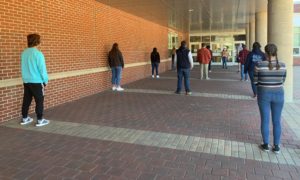
Photo/submitted
By Liz Nolan, Contributing Writer
Northborough/Southborough – The Northborough Southborough Regional School Committee had a full agenda for its Oct. 21 meeting. A summary of the first three weeks of in-person instruction at Algonquin Regional High School (ARHS), an update on COVID-19, and how the virus has impacted the Fine and Performing Arts Department were among the topics.
Health update: District Physician Dr. Safdar Medina, District Health and Wellness Coordinator Mary Ellen Duggan, RN, and their team continue to collaborate with the local Board of Health regarding COVID-19 positive cases and contact tracing. Five positive COVID-19 cases in the ARHS community are active and close contacts were identified; however, there has been no change to the reopening plan and hybrid learning schedule.
The school will continue to monitor the adherence of safety protocols in the effort to mitigate potential in-school transmission. The District health team reminded parents that certain behaviors like sleepovers are deemed high risk and can impact the ability to maintain in-school learning.
Duggan reported that the CDC definition of a close contact was updated on Oct. 21. Someone exposed to an infected person within 6 feet for a cumulative time of 15 minutes is considered a close contact. Previously, that 15 minute exposure time was consecutive time.
Medina reinforced that the PCR test is the required test by the District to return to school. The test should not be done too soon after exposure as the results won’t be meaningful because the incubation period of the virus is 2-14 days.
The District has a comprehensive website (www.nsboro.k12.ma.us) dedicated to COVID-19.
Principal’s update: Principal Sean Bevan reported that the start of in-person learning is overall going well.
“There was an initial steep learning curve for learning our new routines and protocols in the building especially the traffic around the building,” he said. “Each hallway goes in one direction, which took a great deal of time, planning and execution.”
One challenge is to make sure students are staying a safe distance apart.
“Social distancing definitely has required a great deal of effort, time and reminders,” said Bevan. “Teenagers like to be near teenagers.”
He said teachers are finding a way to build a classroom community despite the challenges. They are developing new routines while navigating the limitations that are required and best practices are emerging.
Different approaches are being used, such as holding classes outside and live streaming to include both cohorts. Teachers are able to integrate students who are in the Stand Alone Remote Program (SARP) model into their classes. There are 78 students in SARP–the majority in the 9th and 10th grades.
Bevan said about a third of the teachers are doing some form of live streaming, with more math and science teachers doing so.
Student feedback is that students are enjoying the smaller classes in the hybrid model, which is generally 10-12 students, and they enjoy getting a little bit more attention from the teacher.
“It’s not a surprise…but not something I initially thought kids would respond as well to, but one of the first things they will tell you,” said Bevan.
Regional School Committee member Paul Butka voiced concerns about covering the required curriculum in the new teaching models.
“It’s very difficult to cover that same amount of content in one year with the limitations we have this year,” said Bevan. “We lost ten days at the start of the school year and classes are roughly 7-10 minutes less every class, every day.”
Bevan has asked teachers to identify the most critical standards and prioritize time to make sure they receive the most attention.
A typical remote day varies by student, class and teacher. He said that as things settle in, instructional data will be collected as to what those days look like.
He is looking forward to some normalcy with next week’s spirit week.
Fine and Performing Arts COVID 19 impact: At the start of school, the Fine and Performing Arts Department had some challenges with allowed rehearsal spaces as state guidelines restricted singing and instrument playing to outdoors with 10 feet distancing. As of October 13, indoor playing is now allowed for band with certain safety measures, but choral singing is still restricted.
Department Head Amy Collins said another challenge is navigating the hybrid model when musicians are split between the two cohort schedules.
“We could have nine trumpets one day and none the next day and that is complicated in performing group works with our students in band, orchestra and chorus,” she said. “We really are a team and every part matters.”
In a typical school year, there are concerts and theater productions.
“We are exploring ways to share music and our student work with the community,” said Collins.
A virtual musical theater cabaret with a theme of resilience, hope and bravery is being produced and will be released in December. It will feature a collection of rehearsed vocal solos, small group numbers, monologues and dance numbers.
Visual art students have had to respond to challenges as well including needing individual art kits, not being able to share materials, and having to scale back the size of their artwork so it can easily be transported between home and school.
The full Committee meeting can be viewed at the Northborough Cable link on YouTube.
















